-- Published: Monday, 11 March 2019 | Print | Disqus
This is a pair of photographs taken by Keith Weiner, for a high school project. It seemed a fitting picture for the dual nature of money, the dual nature of wood both as logs to be consumed and dimensional lumber to be used to construct buildings.
Last week, in Is Capital Creation Beating Capital Consumption, we asked an important question which is not asked nearly often enough. Perhaps that’s because few even acknowledge that capital is being consumed, and fewer tie it to the falling interest rate (perhaps that is because the fact of the falling interest rate is, itself, controversial). At any rate, we showed a graph of Marginal Productivity of Debt.
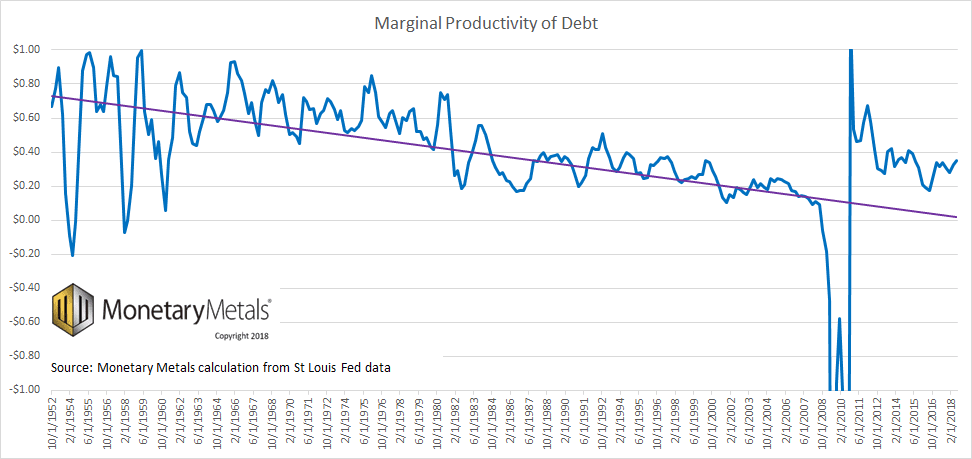
We said that this shows that consumption of capital is winning the race. And promised to introduce another new concept to explain why.
Money Has a Dual Nature
Money, or even an irredeemable currency, has a dual nature (in this article, we will do something we have never done before. Except where specifically said otherwise, we will treat money and currency the same, and when we say money, in this article, we also mean that the same applies to the dollar too).
We assume that readers are familiar with the income side of the duality. One earns $X. One can spend up to $X dollars. The purchasing power paradigm is based on this side of money’s nature. It even goes so far to think of all assets in terms of their liquidation value, and hence purchasing power.
The reason is simple. If the central bank has a mandate to devalue, then one would be a fool to hold a significant money balance for a long period of time. There is an expression that fits this idea perfectly. You put your money into something. It could be stocks, real estate, crude oil, bitcoin, etc. Whatever you expect will go up in purchasing power. We get comments all the time, asserting that the point of owning gold is that it will go up—you guessed it—in terms of purchasing power.
Whether one is earning, or whether one is spending, this is the income side of money. Everyone knows the income side, as they know the sun rises in the east and as they know about gravity.
On the other side of the duality, money is a capital good. Or to be more precise, money is readily exchangeable for any capital good, and money is the measure of all capital goods.
When one earns money, one receives income. One may spend that income, though it is prudent to save some of it. The moment that the money is deposited or otherwise saved, it flips to the other side of the duality. It is not now your income, but your capital. We have written about consuming your capital, of eating your seed corn. That is not our focus today.
Instead, we want to look at the parallel between diminishing marginal productivity of debt and rising capital asset prices. The former says you have to borrow more and more dollars to add one dollar to GDP. The latter says that it takes more and more dollars to buy a capital asset that generates one dollar of income.
Money is a capital asset.
Whether it is a borrowed dollar or an owned dollar, whether it is a money balance in a bank or bond, or whether it is a farm or factory or hamburger restaurant, one needs more and more dollars to generate a dollar of revenues or profits. Why would this be? What would have to be occurring to drive the price of a dollar of revenue up?
Revenue-generating capital assets are becoming scarcer.
It fits either way you look at it. If you buy a capital asset, you have to pay more to get it, or if you sell, you get a higher price. And, the yield generated on a constant-dollar-value capital asset is less. Clearly something is dissipating.
The (Evil) Genius of Keynes
The scarcer capital assets become, the higher their prices.
Let’s consider something John Maynard Keynes said in The General Theory of Employment, Interest, and Money:
“If I am right in supposing it to be comparatively easy to make capital-goods so abundant that the marginal efficiency of capital is zero, this may be the most sensible way of gradually getting rid of many of the objectionable features of capitalism. For a little reflection will show what enormous social changes would result from a gradual disappearance of a rate of return on accumulated wealth. A man would still be free to accumulate his earned income with a view to spending it at a later date. But his accumulation would not grow. He would simply be in the position of Pope’s father, who, when he retired from business, carried a chest of guineas with him to his villa at Twickenham and met his household expenses from it as required.”
Let’s get one thing out of the way, first. Keynes was wrong.
Also, take note of Keynes’ explicit discussion of spending capital. Accumulating capital, in his backwards book, is one of the “objectionable feature of capitalism”. However, consuming capital is declared to be good. Keynes is right there with the prehistorical peoples and animals: subsistence is the preferred way of life.
Now let’s tackle the meat of his claim. It may be easy, as Keynes said, for the government to make the rate of return on capital fall to zero. But of course government has no power to make anything abundant. If it could, then Venezuela would be the richest country in the world (although perhaps it would lag behind Cuba, North Korea, and Zimbabwe).
More Cargo Cult Thinking
The government may not have the power to create capital goods (or cargo) out of thin air. However, it does have power. It can destroy. It cannot will anything into existence. But it can shove a gun in the face of a producer, to make him stop. Or to take away his means of producing, which is the same thing.
Many economists write about how the government taxes, and regulates. And how it sets price caps and price floors. We write mostly about how it manipulates the producer by more subtle means: the interest rate.
The falling interest rate is the same thing as the rising asset price.
The government can perversely incentivize you to consume by raising the liquidation price of capital assets. Notice that liquidation reverses what we described above. When you earned a dollar and set it aside, it became capital. Now, when you liquidate a capital asset, it turns back into income. To be spent. Which the government incentivizes by driving up asset prices (i.e. driving down yields). Some propagandists call this the wealth effect.
Keynes got it exactly backward. Government has not made capital assets abundant. It has perversely incentivized everyone to consume them. And as they become scarcer, their price rises.
We see this in the falling marginal productivity of debt—that is the economic growth created by an additional dollar of capital.
Supply and Demand Fundamentals
The weekly closing prices of the metals were up +$5 and +¢11. But this does not tell the full story of the trading action. The price was dropping until Friday. More precisely, Friday 8am in New York, or 1pm in London.
At that moment, a light cabal conspiring to jack the price struck traders began buying. The end result was the prices, especially of silver, rose on the day and the week. And it happened at the end of a weak with stock market selling. Interesting. And a week where the junk-Treasury spread widened and Treasury yields fell. And even the bulls’ favorite commodity to tout, copper, dropped a bit.
Last week, we quipped that this is how the system is supposed (by our central planners) to work: more borrowing of more dollars to buy all assets including other currencies. Well this week, the magic wasn’t working.
Anyways, let’s look at the only true picture of the supply and demand fundamentals of gold and silver. But, first, here is the chart of the prices of gold and silver.

Next, this is a graph of the gold price measured in silver, otherwise known as the gold to silver ratio (see here for an explanation of bid and offer prices for the ratio). It was down a bit this week.
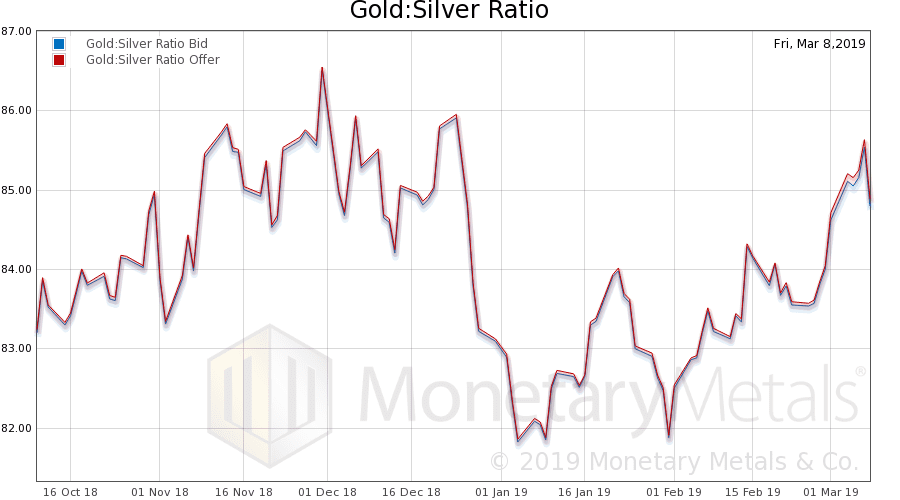
Here is the gold graph showing gold basis, cobasis and the price of the dollar in terms of gold price.
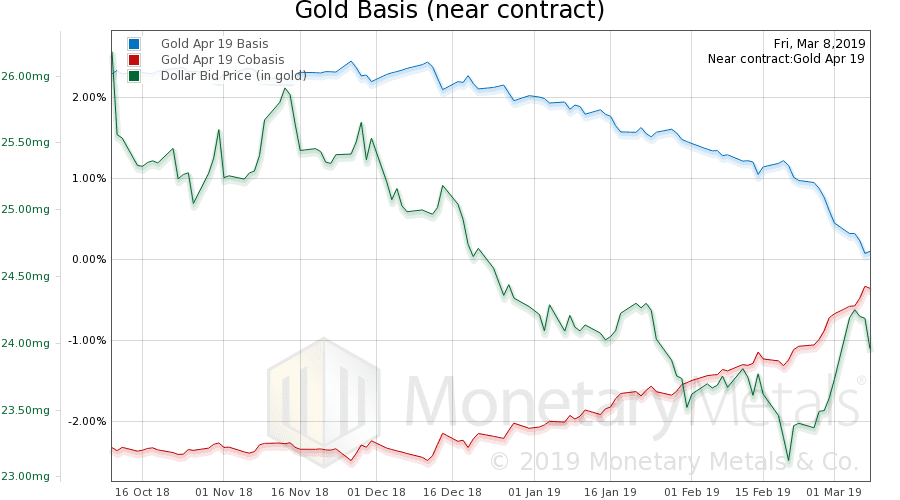
The price of the dollar is down (inverse of the price of gold, in dollars, which is up). And we see a rising scarcity (i.e. cobasis). At least in the April contract—the gold basis continuous is basically flat. This makes sense, the price is not moving much either.
And it means that there is not some kind of magical demand for “phyz” coming out of nowhere.
The Monetary Metals Gold Fundamental Price made another new high, up now to $1,437.
Now let’s look at silver.
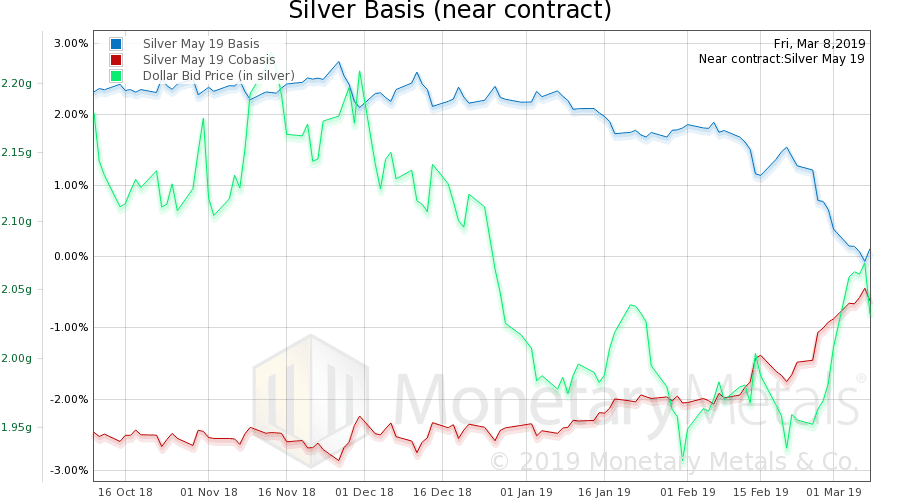
Silver shows the rise in price and rise in scarcity, including of the silver basis continuous.
Here is a graph of the silver price and basis, intraday on Friday.
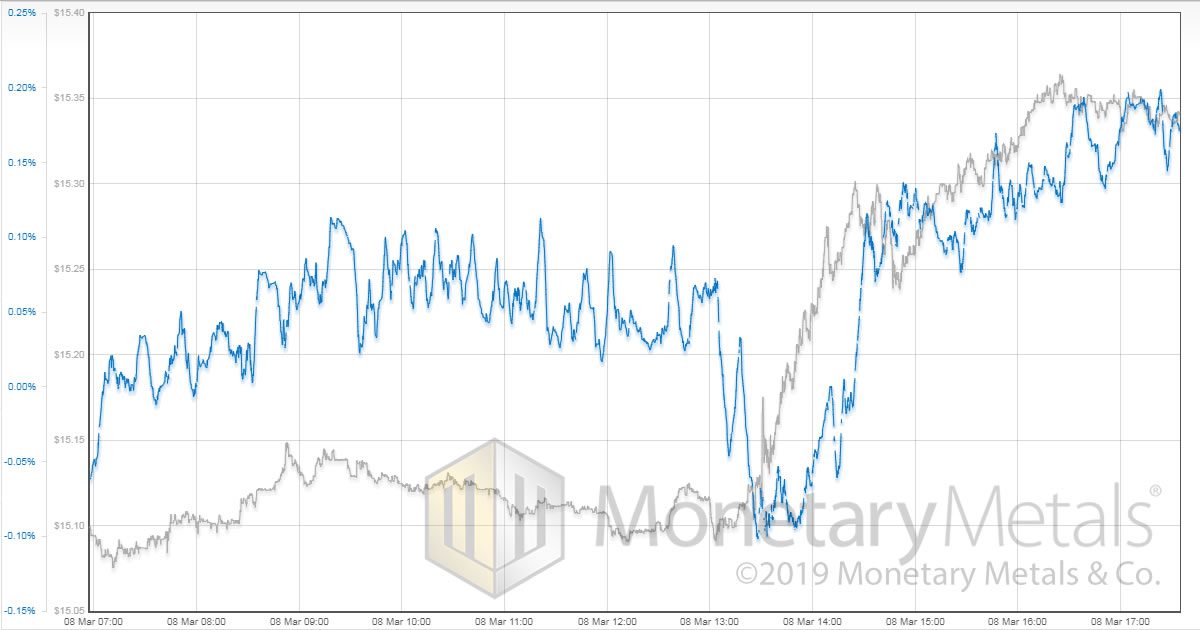
The big price move was about ¢25. There is a basis move upward, along with it, but the basis move is muted for a price move of this size. The basis had been humming along around +5bps to +10bps. After the price jumped, basis is +15bps to +20bps.
And it’s interesting that before the price moves, the basis drops to around -10bps. That was a surge of buying of physical metal. About 30 minutes later, the price begins rising. Then it’s another 30 minutes before the basis begins rising, which means that futures buyers are beginning to react. It’s about 90 minutes before the basis returns to its starting point, but by then the price of silver is $15.28 compared to $15.10 previously.
This zoom in to the details confirms why our calculated fundamental price rose on Friday. It will be interesting to see if there is follow-through buying of metal.
The Monetary Metals Silver Fundamental Price is down another 6 cents to $16.10, though it was down more and then rising the second half of the week.
© 2019 Monetary Metals
| Digg This Article
-- Published: Monday, 11 March 2019 | E-Mail | Print | Source: GoldSeek.com

